Two-dimensional FSI simulation of closing dynamics of a tilting disc mechanical heart valve
- PMID: 20209095
- PMCID: PMC2831756
- DOI: 10.1115/1.4000876
Two-dimensional FSI simulation of closing dynamics of a tilting disc mechanical heart valve
Abstract
The fluid dynamics during valve closure resulting in high shear flows and large residence times of particles has been implicated in platelet activation and thrombus formation in mechanical heart valves. Our previous studies with bi-leaflet valves have shown that large shear stresses induced in the gap between the leaflet edge and the valve housing results in relatively high platelet activation levels whereas flow between the leaflets results in shed vortices not conducive to platelet damage. In this study we compare the result of closing dynamics of a tilting disc valve with that of a bi-leaflet valve. The two-dimensional fluid-structure interaction analysis of a tilting disc valve closure mechanics is performed with a fixed grid Cartesian mesh flow solver with local mesh refinement, and a Lagrangian particle dynamic analysis for computation of potential for platelet activation. Throughout the simulation the flow remains in the laminar regime and the flow through the gap width is marked by the development of a shear layer which separates from the leaflet downstream of the valve. Zones of re-circulation are observed in the gap between the leaflet edge and the valve housing on the major orifice region of the tilting disc valve and are seen to be migrating towards the minor orifice region. Jet flow is observed at the minor orifice region and a vortex is formed which sheds in the direction of fluid motion as observed in experiments using PIV measurements. The activation parameter computed for the tilting disc valve, at the time of closure was found to be 2.7 times greater than that of the bi-leaflet mechanical valve and was found to be in the vicinity of the minor orifice region mainly due to the migration of vortical structures from the major to the minor orifice region during the leaflet rebound of the closing phase.
Figures

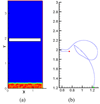

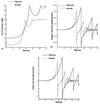
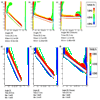

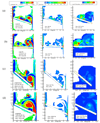
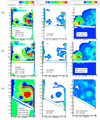
Similar articles
-
Two-dimensional dynamic simulation of platelet activation during mechanical heart valve closure.Ann Biomed Eng. 2006 Oct;34(10):1519-34. doi: 10.1007/s10439-006-9194-5. Epub 2006 Sep 30. Ann Biomed Eng. 2006. PMID: 17013660
-
Two-dimensional simulation of flow and platelet dynamics in the hinge region of a mechanical heart valve.J Biomech Eng. 2009 Mar;131(3):031002. doi: 10.1115/1.3005158. J Biomech Eng. 2009. PMID: 19154061 Free PMC article.
-
Aortic Valve Replacement.2023 May 29. In: StatPearls [Internet]. Treasure Island (FL): StatPearls Publishing; 2025 Jan–. 2023 May 29. In: StatPearls [Internet]. Treasure Island (FL): StatPearls Publishing; 2025 Jan–. PMID: 30725821 Free Books & Documents.
-
Evolving technology: the TRIFLO tri-leaflet mechanical valve without oral anticoagulation: a potential major innovation in valve surgery.Front Cardiovasc Med. 2023 Sep 29;10:1220633. doi: 10.3389/fcvm.2023.1220633. eCollection 2023. Front Cardiovasc Med. 2023. PMID: 37840955 Free PMC article. Review.
-
Flow in prosthetic heart valves: state-of-the-art and future directions.Ann Biomed Eng. 2005 Dec;33(12):1689-94. doi: 10.1007/s10439-005-8759-z. Ann Biomed Eng. 2005. PMID: 16389514 Review.
Cited by
-
Near valve flows and potential blood damage during closure of a bileaflet mechanical heart valve.J Biomech Eng. 2011 Sep;133(9):094507. doi: 10.1115/1.4005167. J Biomech Eng. 2011. PMID: 22010753 Free PMC article.
-
Numerical model of full-cardiac cycle hemodynamics in a total artificial heart and the effect of its size on platelet activation.J Cardiovasc Transl Res. 2014 Dec;7(9):788-96. doi: 10.1007/s12265-014-9596-y. Epub 2014 Oct 30. J Cardiovasc Transl Res. 2014. PMID: 25354999 Free PMC article.
-
Simulation of the microscopic process during initiation of stent thrombosis.Comput Biol Med. 2015 Jan;56:182-91. doi: 10.1016/j.compbiomed.2014.11.006. Epub 2014 Nov 15. Comput Biol Med. 2015. PMID: 25437232 Free PMC article.
-
Estimation of maximum intraventricular pressure: a three-dimensional fluid-structure interaction model.Biomed Eng Online. 2013 Nov 22;12:122. doi: 10.1186/1475-925X-12-122. Biomed Eng Online. 2013. PMID: 24267976 Free PMC article.
-
Role of Computational Simulations in Heart Valve Dynamics and Design of Valvular Prostheses.Cardiovasc Eng Technol. 2010 Mar;1(1):18-38. doi: 10.1007/s13239-010-0002-x. Cardiovasc Eng Technol. 2010. PMID: 20606715 Free PMC article.
References
-
- Bodnar E, Grunkemeier GL, Gabbay S. Heart valve replacement: A statistical review of 35 years results - Discussion. Heart Valve Disease. 1999;8:470–471. - PubMed
-
- Butchart EG, Ionescu A, Payne N, Giddings J, Grunkemeier GL, Fraser AG. A new scoring system to determine thromboembolic risk after heart valve replacement. Circulation. 2003;108 Suppl 1:II68–II74. - PubMed
-
- Giddens DP, Yoganathan AP, Schoen FJ. Prosthetic Cardiac Valves. Cardiovasc. Pathol. 1993;2(S167–S177)
-
- Cannegieter SC, Rosendaal FR, Briet E. Thromboembolic and bleeding complications in patients with mechanical heart valve prostheses. Circulation. 1994;89(2):635–641. - PubMed
-
- Bluestein D, Niu L, Schoephoerster RT, Dewanjee MK. Fluid mechanics of arterial stenosis: relationship to the development of mural thrombus. Ann Biomed Eng. 1997;25(2):344–356. - PubMed
Grants and funding
LinkOut - more resources
Full Text Sources
Miscellaneous
